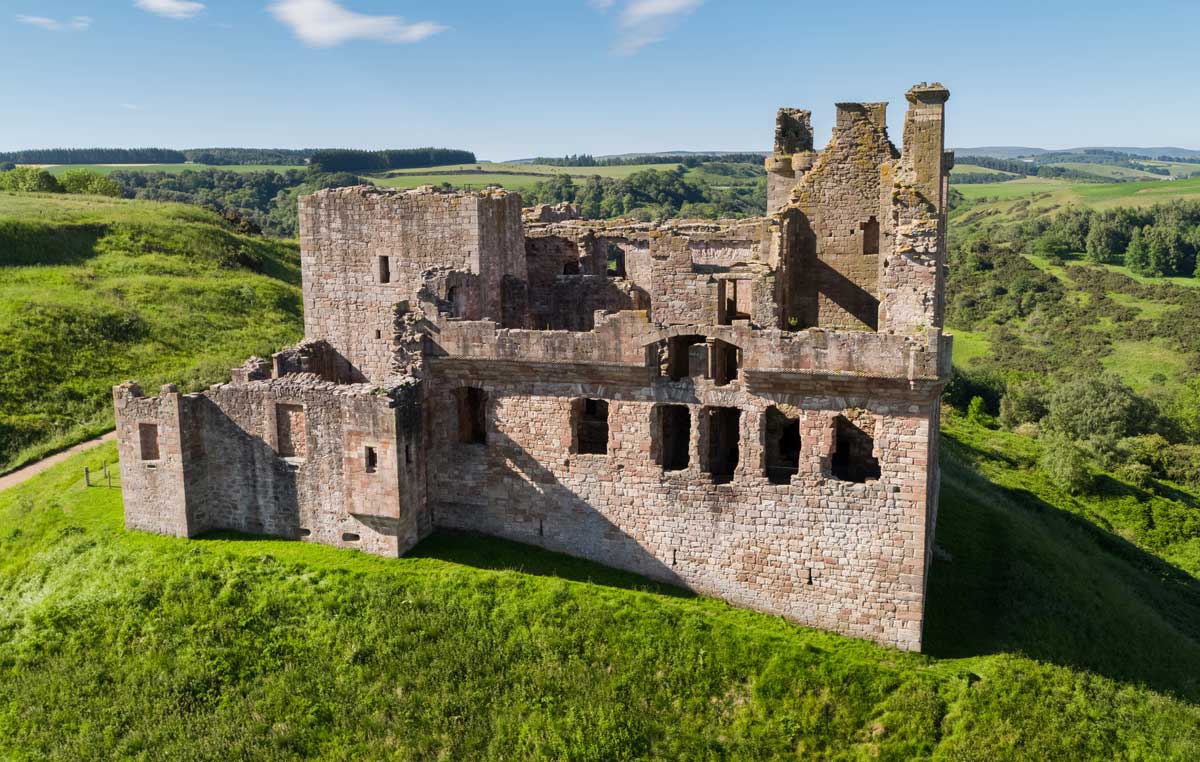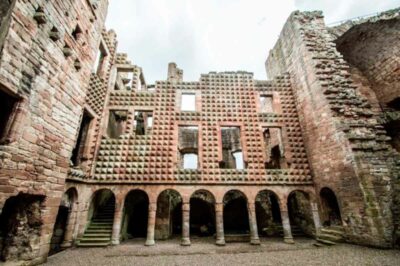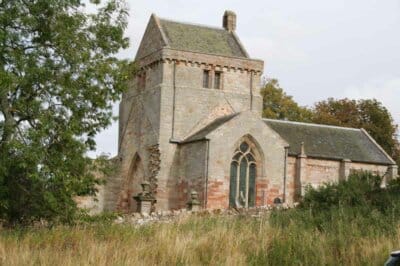
©Historic Environment Scotland
Crichton Castle. Around a dozen miles from the bustle of Edinburgh, is set within the beautiful and tranquil Crichton Glen.
This ancient fortress is often associated with Mary Queen of Scots.
History of Crichton Castle
The first stone structure, which may have replaced an earlier earth and timber fort, was a simple tower house built around 1400 by John de Crichton, who had a charter of barony from Robert III (1390-1406).
The barony of Crichton is recorded as early as the 13th century and it seems, that the castle took its name from the estate as did the first owners.
Following archaeological excavations in 1985, the Society of Antiquaries of Scotland noted that this original building, although now reduced in height, still forms the east side of the castle.
While, over the centuries many people have been associated with the castle there are only a few who have made their mark, for good or bad, both on the castle and on the history of Scotland.
It was John de Crichton’s eldest son William, the first Lord Crichton, who probably built the south and west ranges and extended the north range, the results of which turned Crichton into an impressive courtyard castle befitting the status of an astute and powerful political figure.
William’s rise to political prominence owed much to James I who had returned, in a vengeful mood, to Scotland in 1424 after 18 years in English hands.
It was during this period that James; while still a ‘guest’ of the English became king after the death of his father. Among the first Scottish nobles to welcome him was William Crichton.
William became a gentleman of the king’s bedchamber
In recognition of his support, William was knighted at James’s coronation in May 1424 becoming, within two years, a gentleman of king’s bedchamber a trusted position that allowed him close access to the monarch.
In a study of the period, Alan R Borthwick from the University of Edinburgh pointed to James’s policy of heavy reliance on the advice and support of barons from Lothian as the basis of William’s early political advancement.
He noted for example that Crichton, along with two others, was trusted to consult with Erik, King of Norway and Denmark over the matter of Scotland’s annual payment owed to Norway for the Western Isles.
This agreement was enshrined in the Treaty of Perth signed in 1266 by Magnus IV and Alexander III of Scotland.
Captain of Edinburgh Castle
As other privileges ensued, Crichton strengthened his position at court; in 1432 he was made Master of the King’s Household while also holding the positions of Sheriff of Edinburgh and Captain of Edinburgh Castle.
In February 1437, in a plot instigated by Walter Stewart, the Earl of Atholl, James was stabbed to death in front of his queen and the throne passed to his six-year-old son James II.
It was Archibald Douglas, 5th Earl of Douglas who acted as regent or lieutenant during the minority years, a time of increasing violence and bloodshed as rival groups fought to control the young king.
The Black Dinner
M.H. Brown of St Andrews University, Oxford Dictionary of National Biography painted a stark picture of the event. He said, “The placing of a bull’s head on the table by Sir William Crichton was the signal for their being seized, given the barest formality of a trial, and beheaded.
It is clear that Douglas fell victim to the instability of minority politics.” There were also suggestions that other members of the Douglas family who subsequently gained from the deaths were involved in the event which is known today as the ‘Black Dinner’.
Despite their deaths, the family still dominated Scottish politics but during 1444, Crichton was forced from office. In the following year, after the continued ravaging of each other’s lands, Crichton was besieged in Edinburgh Castle by forces controlled by the new 8th Earl of Douglas.
Related content
Crichton eventually returned to court as chancellor and in 1448 he was sent as one of the king’s ambassadors to France to arrange James II’s marriage to Mary, the daughter of Arnold the Duke of Gueldres.
By the middle of the 15th century ecclesiastical ‘fashion ‘was changing as monasteries, many of which were established centuries earlier, found it increasingly difficult to attract endowments. In their place, new collegiate churches were founded.
Richard Fawcett from Historic Environment Scotland said, “collegiate churches were designed as the setting for a perpetual sequence of prayers for the salvation of their founders.”
Crichton Collegiate Church
Founded in 1449 by William Crichton, Crichton Collegiate Church, still in existence today, is now used for ecumenical worship.
The church, only a short walk from the castle, was one of a number founded in Scotland around the same time; like others, it didn’t survive the Scottish Reformation which forced the abolition of the Catholic mass.
Interestingly Crichton was a contemporary of William St Clair who established Rosslyn Chapel (The Collegiate Church of St Matthew the Apostle, dedicated in 1450) only six miles away, as the crow flies.
William Crichton died in c. 1453 and although his remaining kin flourished briefly it was the third Lord Crichton who brought the curtain down on the family’s association with Crichton Castle following his involvement in a plot against James III.
With Crichton’s disgrace, the estate passed first to the 18-year-old John Ramsay.

He was a favourite of James III but after the king’s death at the Battle of Sauchieburn in 1488, his successor James IV granted the lordships of Bothwell and Crichton to Patrick Hepburn, Lord Hailes who became the first Earl of Bothwell.
Historic Environment Scotland described the Hepburn Earls of Bothwell as, “colourful and unruly,” many would call that an understatement.
Battle of Flodden 1513
Adam the 2nd earl, like Scott’s Marmion, died alongside James IV and many of Scotland’s nobles at the Battle of Flodden in 1513.
He was succeeded by Patrick the 3rd Earl of Bothwell.
In the weeks following the Scot’s defeat at the Battle of Solway Moss and a few days after the birth of his daughter Mary, James V died.
Those events of late 1542 created a dynastic challenge for Scotland, England and France. Who would Mary Queen of Scots marry?
The 3rd earl, no doubt considering the options carefully, took the English path by agreeing to promote the marriage of Henry VIII’s son Edward, the Prince of Wales, to the young Mary Queen of Scots. But he also went further by promising to enlist the support of others in Henry’s ‘Rough Wooing’ campaign.
However, in the transient and uncertain world of Scottish politics, he changed his mind. Historian Marcus Merriman, The Rough Wooing of Mary Queen of Scots said, “he quickly fell from the English faction seduced so it was said by the promise of the hand of Mary of Guise.”

In September 1543, amid great celebrations, the infant Mary was crowned Queen of Scots in the Chapel Royal of Stirling Castle.
Rosalind K. Marshall, Mary of Guise: Queen of Scots citing a ‘chronicler’ said that the Scottish court was like, “Venus and Cupid in the time of fresh May for there was such dancing, singing, playing and merriness as the Earl of Lennox vied with Patrick 3rd Earl of Bothwell for the hand of the widowed queen.”
Patrick of course was already a married man but was prepared to divorce his wife should the opportunity to marry the queen arise.
Mary of Guise
It wasn’t to be for Patrick who the following year and again in 1549 turned once more to the English. On both occasions, he was charged with treason but managed to keep his title and more importantly his life.
He was certainly back in favour by 1556 after Mary of Guise made him lieutenant of the Borders. He died in September of that year and his title passed to his son James Hepburn, 4th Earl of Bothwell.
Although over the centuries Crichton Castle was never the scene of a major battle, it was in October 1559 besieged by Lords of the Congregation after James seized a large sum of money, carried north by John Cockburn of Ormiston from Elizabeth I to support the Protestant cause.
Bothwell refused to return the money which went to support the increasingly difficult position of Mary of Guise.
Other, “great spoil.” Indeed, the castle was ordered to be, “cast down and made uninhabitable” although there is no available evidence which confirms any large-scale destruction at Crichton.
There were of course much happier times at Crichton Castle including the wedding in 1562 of Lady Janet Hepburn, Bothwell’s sister and Lord John Stewart a half-brother of Mary Queen of Scots who attended enjoying in the process “much good sport and many pastimes.”
Other nearby historic attractions to visit
James Hepburn was, despite all his other questionable activities, best remembered as the third husband of Mary Queen of Scots who he married in May 1567 only a few months after the murder of Mary’s second husband Henry, Lord Darnley, an event in which Bothwell was implicated.
In the end, Bothwell’s past having caught up with him found himself a prisoner of Frederick II of Denmark. He died insane, after a number of years in captivity, in terrible conditions in Dragsholm in Zeeland on 14 April 1578.
The barony of Crichton passed to the young Francis Stewart, the son of John Stewart and Janet Hepburn whose wedding Mary Queen of Scots had attended. Francis was immediately faced with the debts inherited by his predecessor whose lifestyle had endangered the family estates.
He was however wealthy and well connected, a combination that made him one of the most powerful men in southern Scotland.
He was educated at the universities of St Andrews, Paris and Rouen and travelled widely on the continent where he developed a love of the arts.
As a Protestant, his relationship with the kirk was complex. He was commendator of Kelso Abbey and Coldingham Priory in addition to being patron of over 50 parish churches.
As a favourite of the king, Francis was given a number of positions. He was variously Sheriff of Lothian and Berwickshire, Great Admiral of the Realm and ambassador to England.
In the end, despite all his advantages in life, a political career that once promised so much ended in charges of witchcraft and treason and ultimately exile in Naples where he died in 1612.
Jacobean Scotland
In a detailed report Robin G Macpherson, Francis Stewart: Lordship and Politics in Jacobean Scotland said, “The political career of the 5th Earl Bothwell demonstrates the complexity of Jacobean Scotland. A close ally of James VI throughout the 1580s, Francis Stewart became, in the end, the greatest threat to the king’s ultimate ambition of the English succession.”
From an architectural perspective, today’s visitors to Crichton Castle have much to admire thanks to Francis Stewart.
He built new lodgings and public rooms; but without doubt the most striking feature still clearly visible is the diamond faceted ‘Italianate’ façade thought to have been influenced by the Palazzo die Diamanti in Ferrara, Italy.
The façade is supported by a loggia of seven arched bays the pillars of which are inscribed FSMD for Francis Stewart and his wife Margaret Douglas.
There is some debate over the timing of the building work; some argue it was completed in time for the visit of James VI in March 1586, while others are more comfortable with a later date. Whatever the timing his Renaissance ideas were ground-breaking in Scotland.
The 5th earl’s son, Francis, who may also have dabbled in the ‘dark arts’, did manage to regain some of the family estates during the reign of Charles I (1625-49) but financial difficulties forced him to sell out to the Hepburns of Humbie.
The castle fell into ruin when much of the stone was used locally for building material.
Crichton Castle & Marmion
Sir Walter Scott chose Crichton as the fictional home of the eponymous hero of his poem Marmion (1808).
He said of the castle, Provincial Antiquities and Picturesque Scenery of Scotland that it sat on the banks of the River Tyne which, “flows through a grassy valley, bounded by sloping banks which, at least till late, being chiefly covered with copse and underwood, formed a wild and beautiful fringe to the level pastureland through which the brook winds.”
This still magnificent building was aptly described by the Object Name Book of the Ordnance Survey as a, “very splendid specimen of the ancient Norman stronghold presenting in its architecture the style of three different ages.”
Although written in 1853, this description still holds true today. Certainly, Historic Environment Scotland considers the castle, because of its continued remodelling over 200 years, “a particularly complex set of ruins.”
Crichton Castle visitor information
For information on opening hours, cost of entry and other tips to help you plan your visit, go to the official Castle website.